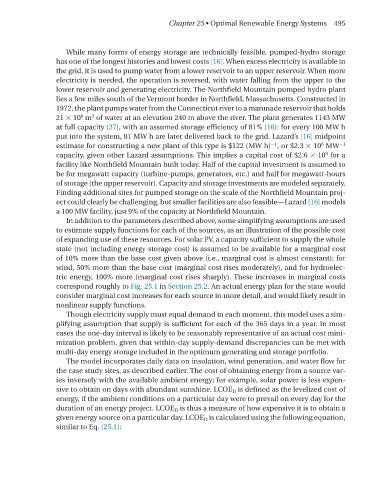Page 482 - A Comprehensive Guide to Solar Energy Systems
P. 482
Chapter 25 • Optimal Renewable Energy Systems 495
While many forms of energy storage are technically feasible, pumped-hydro storage
has one of the longest histories and lowest costs [16]. When excess electricity is available in
the grid, it is used to pump water from a lower reservoir to an upper reservoir. When more
electricity is needed, the operation is reversed, with water falling from the upper to the
lower reservoir and generating electricity. The northfield Mountain pumped hydro plant
lies a few miles south of the Vermont border in northfield, Massachusetts. Constructed in
1972, the plant pumps water from the Connecticut river to a manmade reservoir that holds
3
6
21 × 10 m of water at an elevation 240 m above the river. The plant generates 1143 MW
at full capacity [27], with an assumed storage efficiency of 81% [16]: for every 100 MW h
put into the system, 81 MW h are later delivered back to the grid. lazard’s [16] midpoint
−1
−1
6
estimate for constructing a new plant of this type is $122 (MW h) , or $2.3 × 10 MW
9
capacity, given other lazard assumptions. This implies a capital cost of $2.6 × 10 for a
facility like northfield Mountain built today. half of the capital investment is assumed to
be for megawatt capacity (turbine-pumps, generators, etc.) and half for megawatt-hours
of storage (the upper reservoir). Capacity and storage investments are modeled separately.
Finding additional sites for pumped storage on the scale of the northfield Mountain proj-
ect could clearly be challenging, but smaller facilities are also feasible—lazard [16] models
a 100 MW facility, just 9% of the capacity at Northfield Mountain.
in addition to the parameters described above, some simplifying assumptions are used
to estimate supply functions for each of the sources, as an illustration of the possible cost
of expanding use of these resources. For solar PV, a capacity sufficient to supply the whole
state (not including energy storage cost) is assumed to be available for a marginal cost
of 10% more than the base cost given above (i.e., marginal cost is almost constant); for
wind, 50% more than the base cost (marginal cost rises moderately), and for hydroelec-
tric energy, 100% more (marginal cost rises sharply). These increases in marginal costs
correspond roughly to Fig. 25.1 in section 25.2. An actual energy plan for the state would
consider marginal cost increases for each source in more detail, and would likely result in
nonlinear supply functions.
Though electricity supply must equal demand in each moment, this model uses a sim-
plifying assumption that supply is sufficient for each of the 365 days in a year. in most
cases the one-day interval is likely to be reasonably representative of an actual cost mini-
mization problem, given that within-day supply-demand discrepancies can be met with
multi-day energy storage included in the optimum generating and storage portfolio.
The model incorporates daily data on insolation, wind generation, and water flow for
the case study sites, as described earlier. The cost of obtaining energy from a source var-
ies inversely with the available ambient energy; for example, solar power is less expen-
sive to obtain on days with abundant sunshine. lCoE d is defined as the levelized cost of
energy, if the ambient conditions on a particular day were to prevail on every day for the
duration of an energy project. lCoE d is thus a measure of how expensive it is to obtain a
given energy source on a particular day. lCoE d is calculated using the following equation,
similar to Eq. (25.1):

